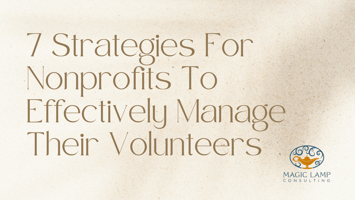Volunteers are the lifeblood of nonprofit organizations, offering their time and expertise to...
Streamline to Serve: 5 Operational Fixes That Save Time and Boost Impact

Nonprofits are constantly balancing the delicate dance between mission-driven work and operational efficiency. While your cause might be your top priority, it’s impossible to make a meaningful impact without running a smooth, organized operation behind the scenes. The better your systems, the more time you have to devote to the people and projects that need your support.
At Magic Lamp Consulting, we’ve seen firsthand how small operational changes can unlock massive improvements in time management, resource allocation, and ultimately, organizational impact. Here are five simple operational fixes that can help your nonprofit save time, reduce inefficiencies, and amplify your mission.
1. Automate Routine Tasks with Technology
One of the easiest ways to streamline operations is to automate repetitive tasks that take up time but don’t require a human touch. From donation processing to scheduling social media posts, there’s a wealth of tools available to help nonprofits stay on top of their administrative workload.
Example Tools:
- Zapier: Automate connections between apps like Gmail, Slack, and Google Sheets.
- DonorPerfect: Automate donor engagement, fundraising campaigns, and thank-you emails.
- Hootsuite or Buffer: Schedule social media posts ahead of time and manage multiple accounts in one place.
By automating time-consuming tasks, you free up your staff to focus on more strategic, impactful work—ultimately driving your mission forward more efficiently.
2. Use Project Management Software for Collaboration
Managing multiple projects and initiatives can be overwhelming, especially when your team is small and your resources are limited. But by implementing a project management tool, you can centralize all communications, track progress, and set deadlines for tasks. This not only helps your team stay organized but also reduces the risk of critical tasks slipping through the cracks.
Example Tools:
- ClickUp: A versatile project management tool with customizable workflows and team collaboration features.
- Trello: An intuitive, board-based system for tracking tasks and progress across teams.
- Asana: An easy-to-use platform for managing tasks, setting milestones, and improving team accountability.
When everyone is on the same page, it’s easier to stay aligned and work toward shared goals, minimizing confusion and boosting productivity.
3. Simplify and Standardize Processes
Nonprofits often operate with limited time and personnel, which is why it’s essential to streamline your processes for maximum efficiency. Standardizing key operations, from onboarding volunteers to grant writing, can save your team countless hours in the long run.
How to simplify:
- Create templates for commonly used documents (e.g., thank-you letters, grant proposals, event planning).
- Develop standard operating procedures (SOPs) for recurring tasks.
- Streamline your onboarding process for new staff or volunteers by providing them with checklists or guides that lay out essential steps.
By eliminating unnecessary steps and standardizing workflows, you increase consistency and reduce the time it takes to complete each task.
4. Improve Communication with a Centralized Hub
Miscommunication is a major culprit behind inefficiency in nonprofit operations. Whether it’s emails getting lost in inboxes or information scattered across different platforms, poor communication leads to missed opportunities and unnecessary delays.
A centralized communication platform can help mitigate these issues, ensuring that your team is always on the same page. Whether you're working remotely or in the office, having a place to store and share important information is key to keeping things running smoothly.
Example Tools:
- Slack: A real-time messaging platform for team communication, file sharing, and collaboration.
- Microsoft Teams: A platform that integrates with Office 365 to streamline chats, calls, and file management.
- Google Workspace: A suite of tools for document collaboration, shared calendars, and email communication.
Centralizing your communication not only helps keep everyone organized but also speeds up decision-making by ensuring that critical information is accessible to all.
5. Focus on Financial Transparency and Budgeting
Nonprofits often juggle multiple funding sources, including grants, individual donations, and fundraising events. Tracking all of this income and ensuring you stay within budget can become a daunting task without the right systems in place.
Investing in financial management tools and practices can help ensure your nonprofit operates within its budget, minimizes waste, and stays financially secure.
Example Tools:
- QuickBooks for Nonprofits: Manage financial reporting, expenses, and budgeting in one place.
(If you use our affiliate links or discount codes, you will receive a discount, and we will receive a small commission.)
- Wave Accounting: A free accounting software designed to track income, expenses, and donations.
- Expensify: A tool to manage receipts and expenses, ensuring financial transparency.
By improving your financial processes, you ensure your nonprofit is more sustainable and can direct more of its resources toward the mission.
Ready to streamline your operations for greater impact?
Contact Magic Lamp Consulting for a free consultation and discover how we can help you run more efficiently and effectively.




